On the Road is a weekday feature spotlighting reader photo submissions.
From the exotic to the familiar, whether you’re traveling or in your own backyard, we would love to see the world through your eyes.
It’s Albatrossity Monday!
We’ll go on a river trip with frosty and then head back to the Yucatan with Uncle Eb.
You may have seen me mention that we are coming up on 1,000 On the Road posts since I started shepherding the series. That happens this week!
To commemorate the occasion, I am going to re-run the two Farewell to Paris posts where Albatrossity and I each chose our favorites from the 5-weeks of Paris posts. Such a lovely series of posts, it’s nice to see the favorites again, so Albatrossity and I thought that would be a fitting way to commemorate 1,000 posts.
The comments were lovely, too, and in those threads we also talked about ideas for OTR, and it was good to see those again, too! I hope you’ll read the posts and read the comments and think about some things we might do going forward.
Albatrossity
Day 2 in the Serengeti started out in the savannah in the morning, and some of those pictures were highlighted in the last installment. We then had lunch and a stroll around our tent camp at Naabi Hill, followed by a trip to Lake Ndutu, which is a destination worth visiting!
These tent camps have quite a few employees, including cooks, waiters, and lots of staff to set up/maintain the tents etc. All of these folks are quite knowledgeable about the plants and animals of the Serengeti, and many of them are aspiring to be guides in the future, and thus eager to practice their English. I was talking to two of the young guys who were washing up the dishes after lunch, and they noticed my omnipresent binoculars and asked if I would be interested in a bird walk in the area after they finished up. Saying “Yes, absolutely!” was my immediate response. And as it turns out, they were hoping to become guides in the future, and eager to show off their knowledge and practice their English. And they were thrilled to be able to borrow the camera and practice their bird photography skills as well! I’m still in contact with one of these guys, and he’s still in training to be a guide.
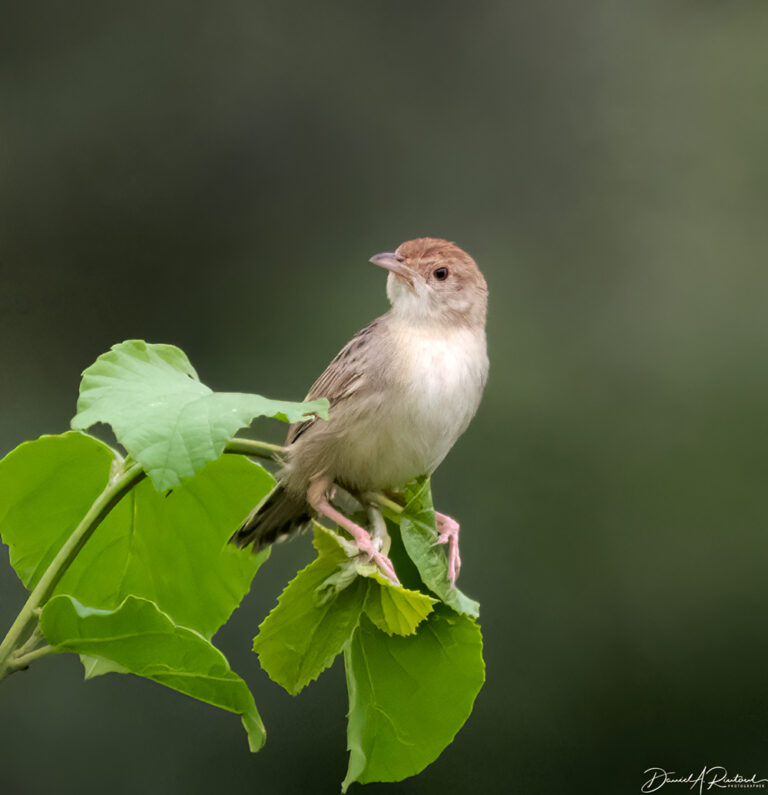
One of the first birds we saw on that excursion was this guy. Actually, we heard it first, and I asked if they knew that birdsong. Of course they did, and it turns out that vocalizations are the best way to ID most the species in this family CIsticolidae, since they all look pretty much alike. This is a Rattling Cisticola (Cisticola chiniana), and for those of you who think that North American sparrows are uncolorful and hard to visually identify, you should thank the FSM that we don’t have cisticolas on this continent! And interestingly, their diagnostic vocalizations don’t sound much like a rattle, at least to me. Click for larger image.
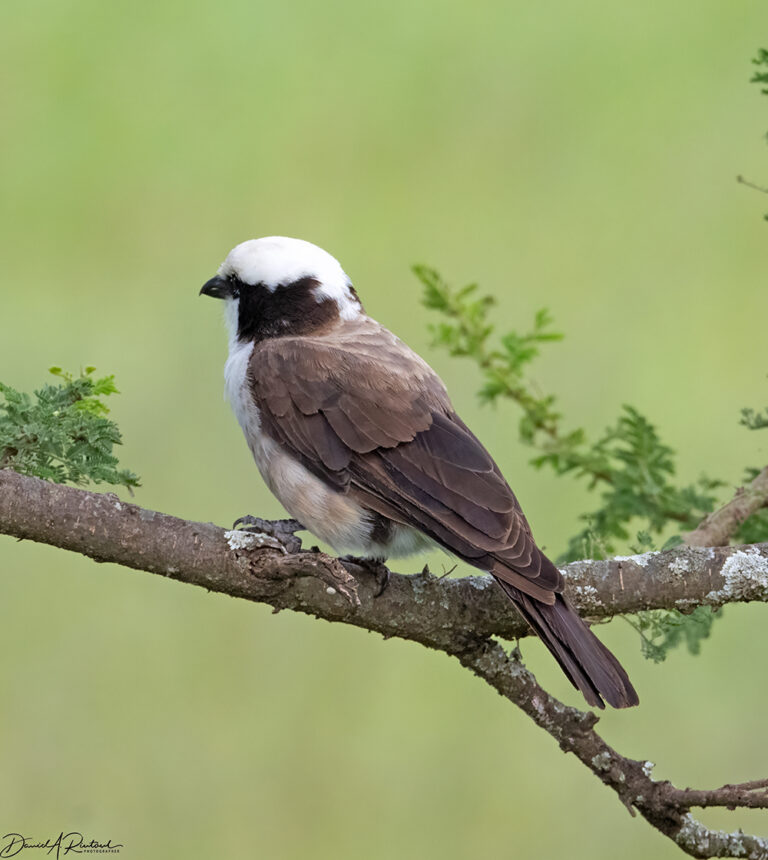
We were also delighted to find this bird, a Northern White-crowned Shrike (Eurocephalus rupelli, aka White-rumped Shrike), feeding youngsters on a small shrub near the camp. It was dropping to the ground to catch insects (primarily grasshoppers), then hopping back up to feed a scattered trio of young shrikes. Click for larger image.
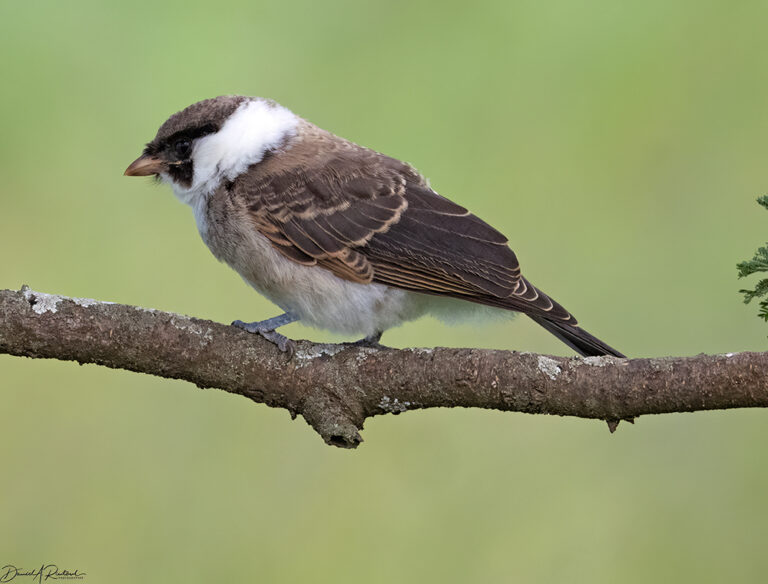
And here is one of those youngsters. Fluffy and brown- (rather than white-) crowned, it looks pretty well-fed! Click for larger image.
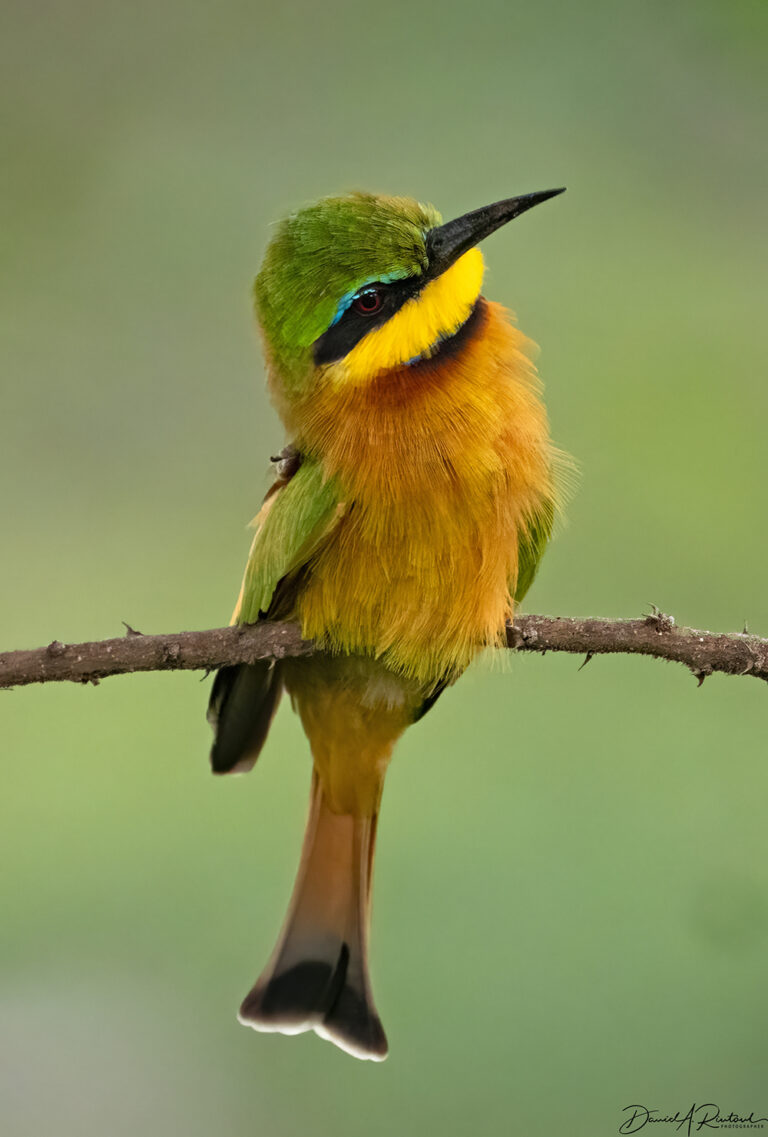
One of the most colorful groups of birds in the Old World, with no representatives in the Americas, would be the bee-eaters, members of the family Meropidae. We were thrilled to find a pair of these Little Bee-eaters (Merops pusillus) behind one of the tents, perched on a tent rope. One of them moved to a more photogenic natural perch, thankfully. Irresistibly cute, they are! Click for larger image.
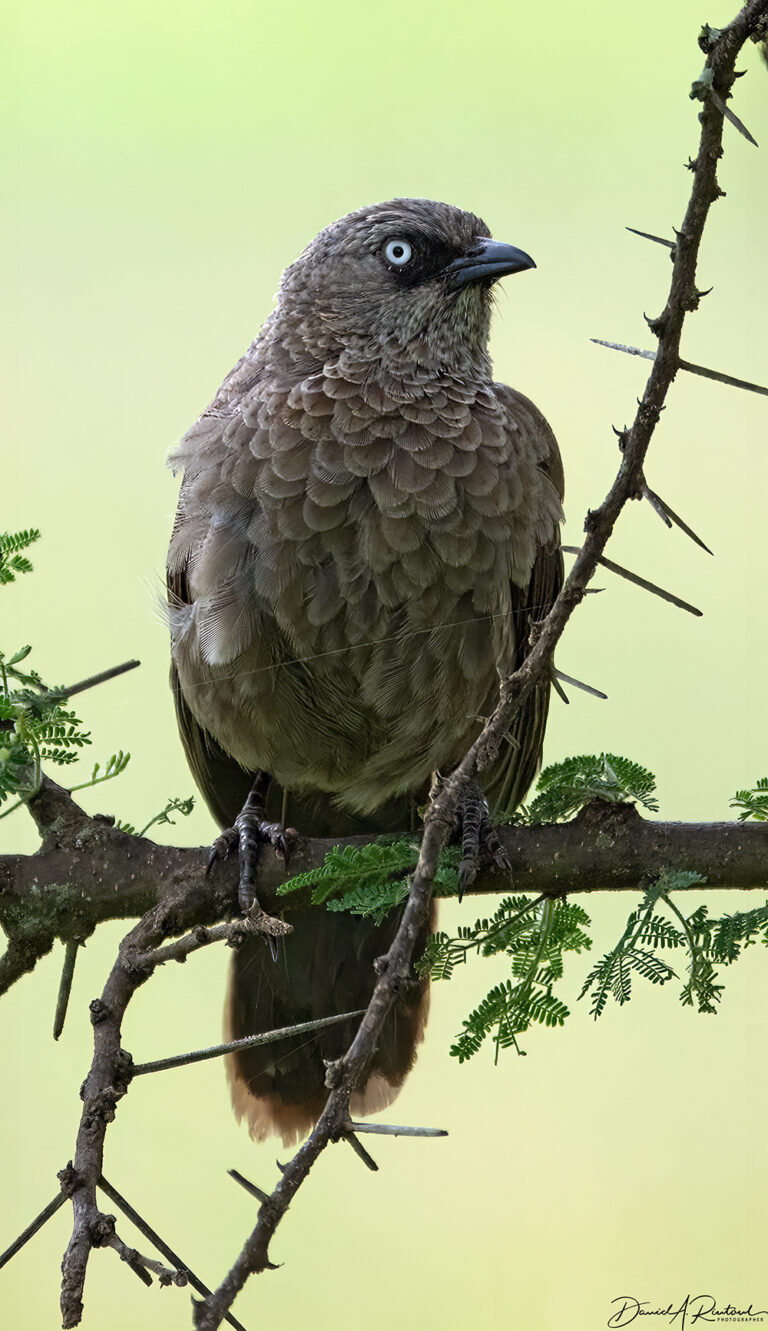
This bird stumped the two guides-in-training, and since I did not have my field guide with me, it elicited lots of discussion (which I stayed out of). They finally IDed it as an Arrow-marked Babbler, which indeed it does resemble, but it does not seem to have the eponymous arrowhead markings on the breast. Later, before dinner, we got together again with the field guide in hand, and figured out that it is another closely-related babbler, the Black-lored Babbler (Turdoides sharpei). It was a life bird for all three of us! It was also one of the birds that they photographed, using my camera, so I was able to send them the pictures later, via the miracle of WhatsApp. Interestingly, since this trip in 2018, both of these species have been moved out of the babblers (family Timaliidae) into the laughingthrushes (family Leiothrichidae). Taxonomists sure do keep busy… Click for larger image.
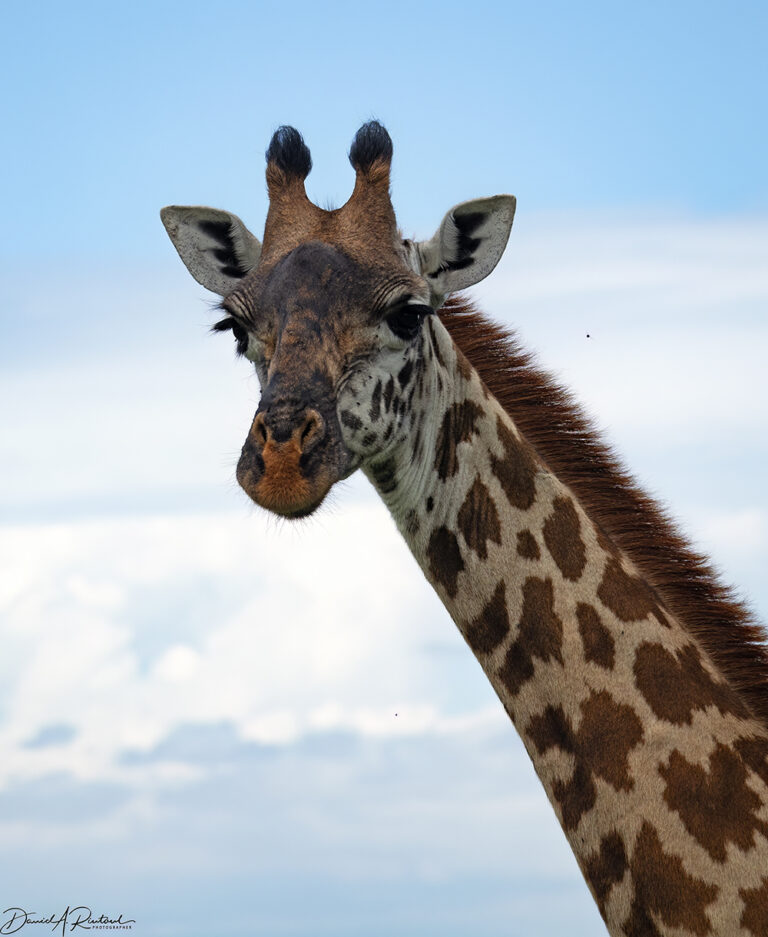
There were several tents set up for our group, as well as several well-prepared tent pads (basically large sandboxes framed with timbers). In one of those we found lots of giraffe tracks, and as we moved further on, we found this giraffe hanging out with some friends in the brush. Click for larger image.
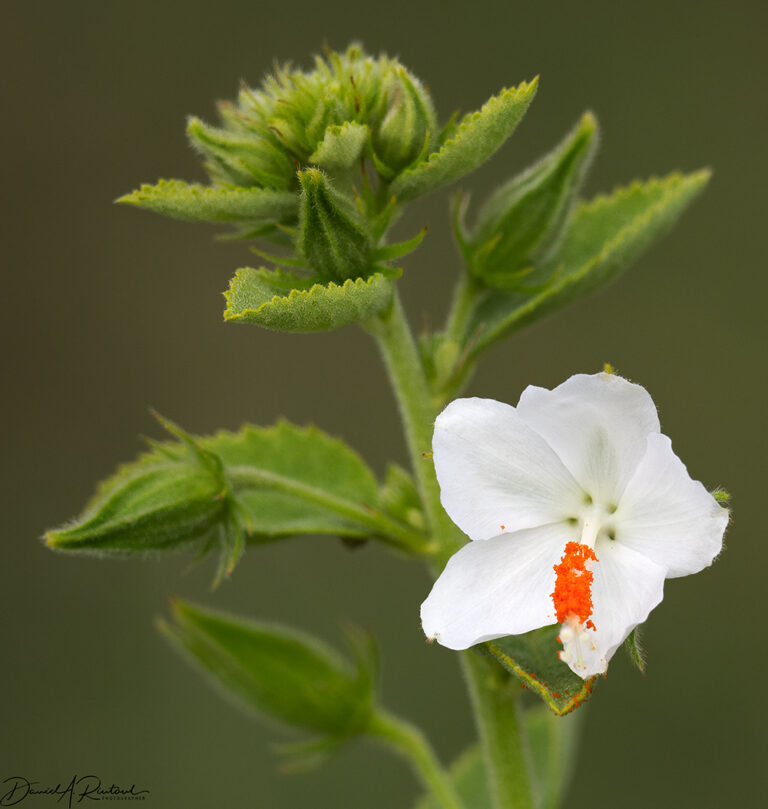
For the gardeners here, a picture of a flower! The two guides-in-training had some botanical knowledge as well, but we were all puzzled by this one. I thought it looked like a hibiscus, and indeed that is what it turned out to be. Hibiscus flavifolius, aka bimbi bimbi. Click for larger image.

We then headed out to Lake Ndutu, which was a few miles away. It had recently rained, so the drivers were a bit worried about the “road” to the lake, and indeed it was a pretty muddy ride. But that meant that we took some time, and found some shorebirds in the puddles along the way, including this Black-winged Lapwing (Vanellus melanopterus). The black part of the wing is on the underside and is not obvious on a sitting bird. Personally I would have named it the Crazy-eyed Lapwing. That’s probably why I am not a taxonomist… Click for larger image.
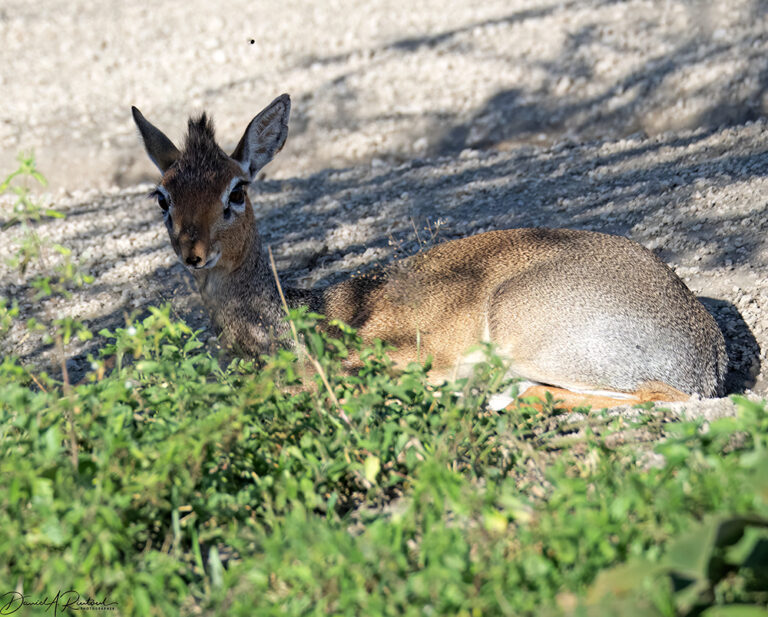
In the sandy area near the lake we saw our first and only Dik-dik. These are the smallest antelopes, and there are actually four species of them, all found in eastern Africa. This one is Kirk’s Dik-dik (Madoqua kirkii), and it may hold the record for the most repetitions of the letter “K” in an animal name. Click for larger image.
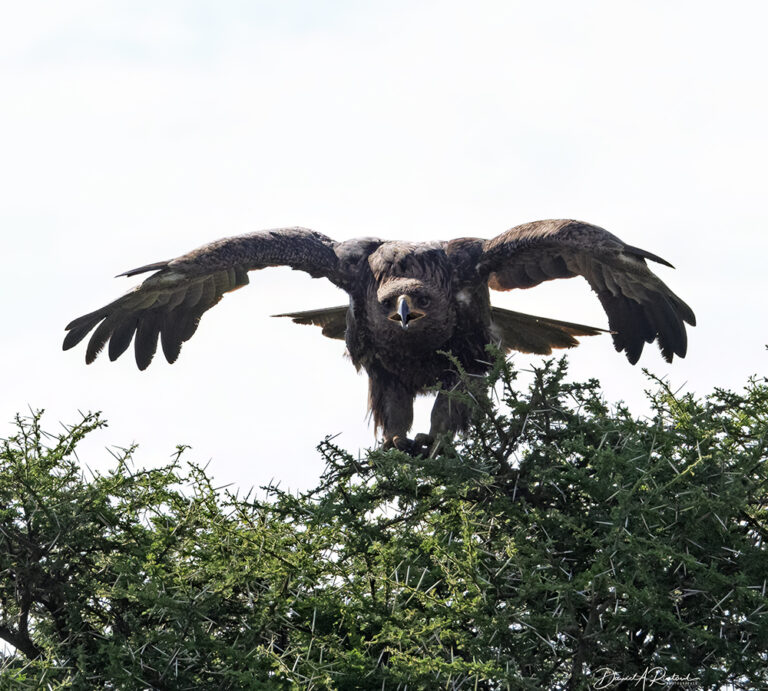
A nearby acacia tree hosted the nest of this Tawny Eagle (Aquila rapax), and it was not happy to see us. It probably would have been happy to see the Dik-dik, however… Click for larger image.

raven
Awesome, as usual!
whatsleft
Well done! Thank you for sharing such beautiful pictures and enlightening commentary.
Deputinize Eurasia from the Kuriles to St Petersburg
You’ve got such a way with cameras that I don’t. What are you using?
Albatrossity
@Deputinize Eurasia from the Kuriles to St Petersburg: Thanks! These were all shot with a micro 4/3 system rig. Olympus OM-D M1 Mk II body and the 100-400mm Panasonic/Leica lens, which is actually 200-800mm on that crop-sensor body.
It was all pretty new at the time, so I was learning how to use it in Tanzania. Fortunately there are lots of opportunities for photographs there!
O. Felix Culpa
Glad to see your photos again! I worked in eastern and southern Africa for a number of years, and was wowed by the birdlife there, as well as the amazing animals one could see on safari. You might be interested in this article a friend wrote about the survival of the crested crane, which is truly a magnificent bird.
lashonharangue
Great photos as usual. Dik-diks are so cute! Their eyes are so big for their size of the head they look like anime.
sab
What kind of giraffe was that?. I only learned last year that there are multiple varieties of giraffes. Their spots and their horns vary. Who knew? Everyone in Africa but hardly anyone in Ohio.
cope
Lovely pictures, thank you. As usual, while scrolling through, I note one I like the most (hello, Mr./Ms. Giraffe) only to get to later shots that catch my fancy even more. This time, my favorite is the last, the raptor.
Thanks again.
PS Maybe you could do a post sometime of what your taxonomic names would be for a collection of creatures as you did with the Lapwing.
Dagaetch
Fabulous pictures as always. I especially like the bee eater one – that little bird has such presence!
BigJimSlade
I prefer your name for the Crazy-eyed Lapwing.
Albatrossity
@sab: I believe that all the giraffes we saw in that part of TZ were Maasai giraffes (Giraffa camelopardalis tippelskirchi).
WaterGirl
Wow, that giraffe! And the crazy bird! All so lovely.